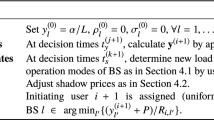Abstract
In order to improve the utilization of channel resources, modern technologies of self-organizing wireless system increasingly use methods of deterministic access, in which the stations preliminary reserve time intervals for packet transmission. To reduce the overhead caused by the distributed reservation of time intervals, these intervals have equal duration and are strictly periodic, i.e., equidistant from each other. Typically, the reservation periodicity is chosen according to the properties of a particular data stream. In the present work, we show that this approach is inefficient and propose a new method in which the periodicity is a multiple of a number called the basic periodicity. Using analytical modeling and simulation we show that the proposed method significantly increases the network capacity.
Similar content being viewed by others
References
M. Perry et al., “Dealing with mobility: understanding access anytime, anywhere,” ACM Trans. Comp.Human Interact. 8, 323–347 (2001).
IEEE 802.11-2007 Standard for Information Technology–Telecommunications and Information Exchange between Systems–Local and Metropolitan Area Networks–Specific Requirements, Part 11: Wireless LAN Medium Access Control (MAC) and Physical Layer (PHY) Specifications (IEEE, New York, 2007).
IEEE Standard for Information Technology–Telecommunications and Information Exchange between Systems–Local and Metropolitan Area Networks–Specific Requirements, Part 11: Wireless LAN Medium Access Control (MAC) and Physical Layer (PHY) Specifications, Amendment 10: Mesh Networking (IEEE, New York, 2011).
IEEE Standard for Information Technology–Telecommunications and Information Exchange between Systems–Local and Metropolitan Area Networks–Specific Requirements, Part 11: Wireless LAN Medium Access Control (MAC) and Physical Layer (PHY) Specifications, Amendment 3: Enhancements for Very High Throughput in the 60 GHz Band (IEEE, New York, 2012).
IEEE P802.11ah/D4.0 Draft Standard for Information technology–Telecommunications and Information Exchange between Systems–Local and Metropolitan Area Networks–Specific requirements, Part 11: Wireless LAN Medium Access Control (MAC) and Physical Layer (PHY) Specifications, Amendment 6: Sub 1 GHz License Exempt Operation (IEEE, New York, June, 2015).
A. G. Kiryanov, A. I. Lyakhov, and E. M. Khorov, “Modeling of real-time multimedia streaming with deterministic access,” J. Commun. Technol. Electron. 59, 1501–1511 (2014).
A. S. Ivanov, E. M. Khorov, and A. I. Lyakhov, “Analytical model of batch flow multihop transmission in wireless networks with channel reservations,” Autom. Remote Control 76, 1179–1192 (2015).
E. Khorov, A. Krasilov, A. Krotov, and A. Lyakhov, “Deterministic channel access in Wi-Fi Mesh networks: open issues and possible solutions,” Submitted to IEEE Wireless Networks.
E. Khorov, A. Lyakhov, A. Krotov, and A. Guschin, “A survey on IEEE 802.11ah: An enabling networking technology for smart cities,” Comput. Commun. 58, 53–69 (2015).
The NS-3 network simulator. http://wwwnsnamorg.
S. R. Saunders and A. Aragon-Zavala, Antennas and Propagation for Wireless Communication Systems (Wiley, Hoboken, NJ, USA, 2007).
Recommendation G.729–Coding of Speech at 8 kbit/s Using Conjugate-Structure Algebraic-Code-Excited Linear Prediction (CS-ACELP) (ITU-T, January 2007).
Author information
Authors and Affiliations
Corresponding author
Additional information
Original Russian Text © E.M. Khorov, 2015, published in Informatsionnye Protsessy, 2015, Vol. 15, No. 1, pp. 78–88.
Rights and permissions
About this article
Cite this article
Khorov, E.M. Choosing the channel reservation period in self-organizing wireless networks. J. Commun. Technol. Electron. 60, 1372–1378 (2015). https://doi.org/10.1134/S1064226915120128
Received:
Published:
Issue Date:
DOI: https://doi.org/10.1134/S1064226915120128



